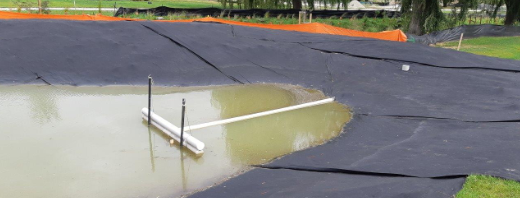New provisions in the ORC’s Regional Plan Water became operative in September last year, strengthening the management of discharges to water, and means that in some development situations consents are required.
“If you’re planning an earthworks project in the Otago region, including small scale works on private property, you will need to make sure you meet the rules. Having a clear plan for erosion and sediment control, getting the right consents and then remaining compliant, protects you, your property and the environment” says ORC’s Senior Environmental Officer Melanie Heather.
“Earthworks activities, if not managed properly can lead to soil loss into waterways which can be detrimental to eco systems and water quality,” says Ms Heather.

“It’s important to follow erosion and sediment control best practice guidance to minimise the adverse effects of erosion and sediment throughout your project,” Ms Heather says.
There have been past instances around Otago where sediment was flushed off earthwork sites into nearby creeks, streams and lakes following rainfall.
Ms Heather says ORC’s Compliance team has developed the guide to provide context to ORC’s residential earthworks provisions, consenting information and on-going consent compliance requirements.
The guide includes content required for any Environmental Management Plans and Erosion and Sediment Control Plans, which are required for most of the consents granted by the ORC, she says.
“The guide is aimed at developers, contractors and service providers in the construction industry,” she says.

Turbidity guide; an alternative measurement for suspended sediment and/or visual clarity in waterways.
As a guideline document, people should read Auckland Council’s Erosion and Sediment Control Guide for Land Disturbing Activities in the Auckland Region Guidelines Document 2016/005 (GD05), which provides for erosion and sediment control best practice.
Ms Heather says the guide was developed in-house with engagement with district councils in Otago and has been independently reviewed.
Residential Earthworks Guide in Otago
Earthworks for residential development – good practice guide
Main changes for property developers
The main changes for property developers are in Rule 14.5 of the ORC’s Regional Plan: Water for Otago.
Part G covers sediment from earthworks for residential development, which are permitted activities with no resource consent required.
For residential earthworks to be a permitted activity, developers must not expose more than 2,500 square meters of earthworks in any consecutive 12-month period per landholding and the earthworks must not be within 10 metres of a water body, drain, water race or the coastal marine area.
The exposed earth must be stabilised on completion of the earthworks, to minimise erosion and to avoid slope failure.
Soil or debris from earthworks must not be placed where it can enter a water body, drain, race or the coastal marine area and there must be no conspicuous change in colour, odour or significant effect on aquatic life.
The earthworks must not result in flooding, erosion, land instability, subsidence or property damage at or beyond the property’s boundary. Earthworks should not occur on contaminated or potentially contaminated land.
If developers cannot meet these “permitted activity” requirements, they will then need to get a resource consent. Developers, or anyone undertaking this activity are encouraged to contact Council if they have any questions or think they may need consent.
Further assistance on consent processing is available at public.enquiries@orc.govt.nz or call 0800 474 082.
June 2023
PDF | 2 MB
A guide for developers, landowners, contractors, and service providers
June 2023
PDF | 2 MB
Earthworks are a necessary part of preparing land for residential development, but if the right practices aren’t used, soil can be lost to water bodies.
February 2020
PDF | 19 MB


